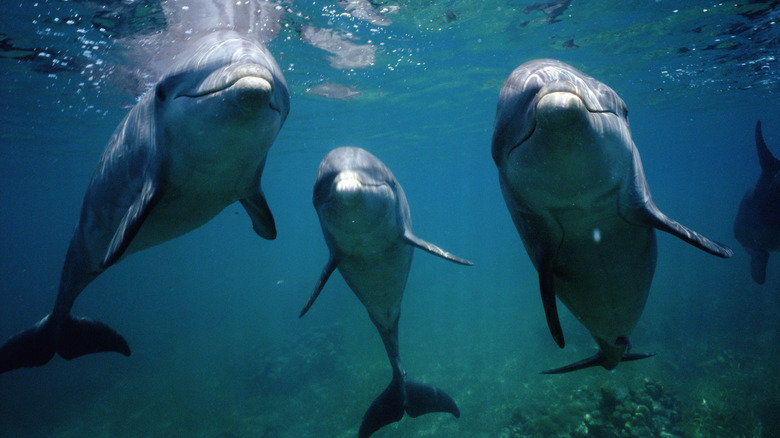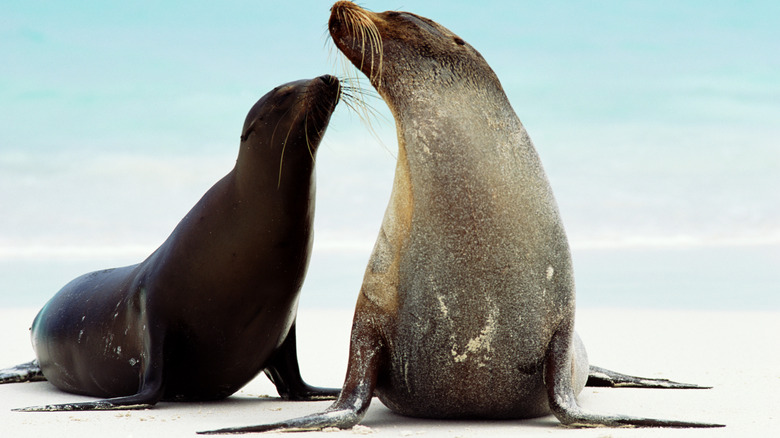The Reason California's Sea Lions And Dolphins Are Attacking Humans Is So Heartbreaking
The conservation of our seas is more vital than ever. In 2022, the International Union for Conservation of Nature reported that over 1,550 marine species are at risk of extinction due to various factors, including climate change, overfishing, pollutants, habitat loss, and algal blooms. Yet, this situation goes beyond disappearing species. Some marine animals have begun to act out due to their threatened environment, including reports of sea lions and dolphins attacking humans.
The cause? Domoic acid toxicosis (also known as amnesic shellfish poisoning) from toxic algal bloom in California's waters. In sea lions, the condition can cause confusion, leading to confrontations. Rj LaMendola, a surfer attacked in March 2025, took to Facebook with his experience, stating, "...out of nowhere, a sea lion erupted from the water, hurtling toward me at full speed. Its mouth gaped wide, teeth flashing, and its eyes locked onto me with an unsettling ferocity." LaMendola later added, "[I]ts expression was feral, almost demonic." While LaMendola's attack happened recently, the strange and tragic case of the Californian sea lions isn't a new phenomenon. The first major outbreak occurred in 2023, affecting 120 sea lions in just seven weeks.
The affected dolphin population is becoming increasingly concerning, as domoic acid toxicosis is a death sentence for them, while sea lions can be treated. By the end of March, over 70 dolphins had been found stranded with the affliction, and many that weren't already dead had to be euthanized (via CNN). Overall, the effects of domoic acid toxicosis on dolphins and sea lions are already high in 2025, with hundreds of recorded cases as of March, and these stats act as a call for better preservation efforts.
How domoic acid toxicosis affects marine life and how to fight against it
A harmful algal bloom toxin, or HAB toxin, can take various forms, but domoic acid remains the most prevalent and severe. The toxin is spread through several diatom species (algae), working its way up the food chain to larger marine life. It affects the brain and various other vital organs, with infected marine life typically found stranded on shores, often deceased. Seizures, foaming at the mouth, lethargy, and disorientation are all signs of the toxin.
The HAB toxin impacts adult females at higher rates than males and can be spread to offspring. Moreover, affected females can't easily care for their newborns, threatening population growth. While the condition is treatable in some species, long-term damage reduces reproductivity and chances of survival. Californian sea lions boast an impressive lifespan beyond many cats and dogs, between 15 and 20 years in the wild and up to 30 in captivity. Comparatively, dolphins can live between 20 and 40 years in the wild. Having a life cut short for either of the remarkable creatures is deeply tragic.
Cohabitating with such incredible creatures comes with responsibilities, and people can make an impact. The Marine Mammal Care Center Los Angeles, a non-profit organization dedicated to conserving and rehabilitating wildlife, accepts donations and volunteers. The center also suggests simple life changes: raising awareness of the effects of global warming, eating less meat (even abstaining once a week), and sharing the shoreline with marine wildlife. Together, humans can help slow the spread of harmful toxins and help build a better future environment for aquatic life.
Interested in more articles on conservation and marine life? Check out the importance of Contender, the largest great white shark to be tagged in the Atlantic.

